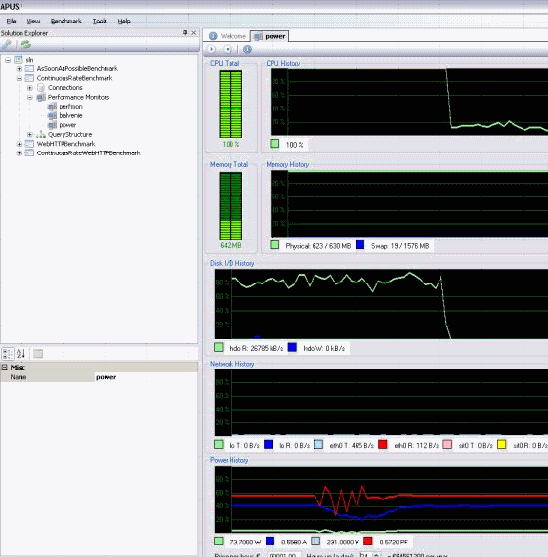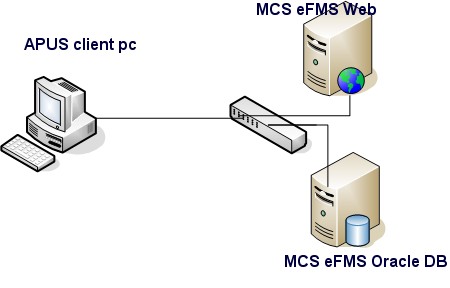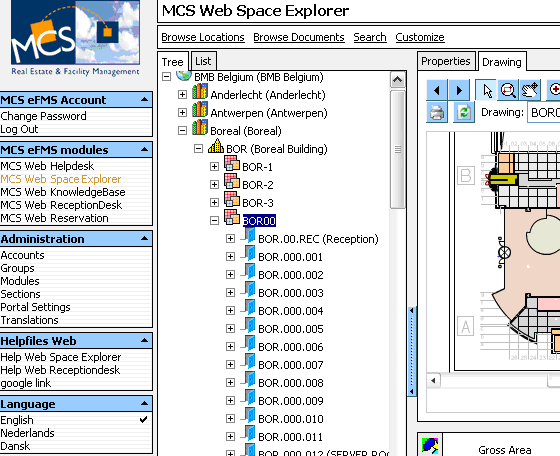Supermicro's Twin: Two nodes and 16 cores in 1U
by Johan De Gelas on May 28, 2007 12:01 AM EST- Posted in
- IT Computing
APUS: a new way of benchmarking
Using industry benchmarks and full disclosure of testing methods is important, as it allows other people to verify your numbers. Therefore we have included a benchmark that everyone can verify (3DS Max architecture rendering). However, testing with real heavy duty applications is so much more interesting. These are the applications that are running in the datacenters, not SPECjbb or TPC. People really care about the performance, as when the applications start to crawl, it affects their work and business. Therefore, let me introduce you to our completely new way of benchmarking with our unique software, called APUS.
As many of our loyal readers know, quite a few of the IT-based articles are based on a close collaboration with the server lab of the College University of West-Flanders. While the academic server research is beyond the scope of this article, the main advantage is that we get the opportunity to work with IT firms which develop rather interesting server applications.
Of course testing these applications is rather complex: how can you recreate the most intensive parts of the real world use of an application and get at the same time a very repeatable and reliable real world benchmark? The answer lies in software developed at the same university called APUS. APUS (or Application Unique Stress-testing) allows us to use the logs of real world applications and turn them into a repeatable benchmark. The application is able to read the logs of almost every popular relational Database (DB2, Oracle, Sybase, MySQL, SQL server, PostGreSQL...) and web applications out there.
We are also working on "special protocols" so we can also use this benchmarking method for other socket applications. A highly tuned threading system allows us to simulate a few thousand users (and more) on one dual core portable. Complex setups with tens of clients are not necessary at all.

There is more: thanks to the hard work of Leandro, Ben, Brecht, and Dieter, APUS is much more than the typical stress tests you can find all over the web. It integrates:
You may expect us to test with several real world applications in the future, but for now, let me introduce you to our first "as real world as it can get" application: MCS eFMS.
MCS eFMS software suite
One of the very interesting and more processing intensive applications that we encountered was developed by MCS. The MCS Enterprise Facility Management Solutions (MCS eFMS) is a state-of-the-art Facility Management Information System (FMIS). It includes applications such as space management (buildings), asset management (furniture, IT equipment, etc.), helpdesk, cable management, maintenance, meeting room reservations, financial management, reporting, and many more. MCS eFMS stores all information in a central Oracle database.
What makes the application interesting to us as IT researchers is the integration of three key technologies:
It uses the following software:
The client, database server, and web server are connected via the same D-link Gigabit Switch. All cable connections worked at 1 Gbit/s full duplex

The only difference is that the hundreds of simulated users access the web server over one Gigabit Ethernet connection, while in the real world people access the MCS web applications over internal LANs as well over different WAN connections. As some of the pages easily take 400 to 800 ms (and higher under heavy load!) between receiving and sending the request, the few milliseconds that a good internet connection adds will not be significant.
MCS received a detailed and accurate model of how the web server and the clients react under different loads, large user groups or heavy pages, which enables them to optimize the MCS eFMS suite even more. Let us see the most interesting results of that report.
Using industry benchmarks and full disclosure of testing methods is important, as it allows other people to verify your numbers. Therefore we have included a benchmark that everyone can verify (3DS Max architecture rendering). However, testing with real heavy duty applications is so much more interesting. These are the applications that are running in the datacenters, not SPECjbb or TPC. People really care about the performance, as when the applications start to crawl, it affects their work and business. Therefore, let me introduce you to our completely new way of benchmarking with our unique software, called APUS.
As many of our loyal readers know, quite a few of the IT-based articles are based on a close collaboration with the server lab of the College University of West-Flanders. While the academic server research is beyond the scope of this article, the main advantage is that we get the opportunity to work with IT firms which develop rather interesting server applications.
Of course testing these applications is rather complex: how can you recreate the most intensive parts of the real world use of an application and get at the same time a very repeatable and reliable real world benchmark? The answer lies in software developed at the same university called APUS. APUS (or Application Unique Stress-testing) allows us to use the logs of real world applications and turn them into a repeatable benchmark. The application is able to read the logs of almost every popular relational Database (DB2, Oracle, Sybase, MySQL, SQL server, PostGreSQL...) and web applications out there.
We are also working on "special protocols" so we can also use this benchmarking method for other socket applications. A highly tuned threading system allows us to simulate a few thousand users (and more) on one dual core portable. Complex setups with tens of clients are not necessary at all.

There is more: thanks to the hard work of Leandro, Ben, Brecht, and Dieter, APUS is much more than the typical stress tests you can find all over the web. It integrates:
- the monitoring of many important client parameters
- and server parameters
- performance measurements
- and is able to capture the corresponding power consumption in real time, making use of the EXTECH 380801
You may expect us to test with several real world applications in the future, but for now, let me introduce you to our first "as real world as it can get" application: MCS eFMS.
MCS eFMS software suite
One of the very interesting and more processing intensive applications that we encountered was developed by MCS. The MCS Enterprise Facility Management Solutions (MCS eFMS) is a state-of-the-art Facility Management Information System (FMIS). It includes applications such as space management (buildings), asset management (furniture, IT equipment, etc.), helpdesk, cable management, maintenance, meeting room reservations, financial management, reporting, and many more. MCS eFMS stores all information in a central Oracle database.
 |
| MCS eFMS integrates space management, meeting room reservations and much more Click to enlarge |
What makes the application interesting to us as IT researchers is the integration of three key technologies:
- A web-based front end (IIS + PHP)
- Integrated CAD drawings
- Gets its information from a rather complex, ERP-like Oracle database.
It uses the following software:
- Microsoft IIS 6.0 (Windows 2003 Server Standard Edition R2)
- PHP 4.4.0
- FastCGI
- Oracle 9.2
The client, database server, and web server are connected via the same D-link Gigabit Switch. All cable connections worked at 1 Gbit/s full duplex

The only difference is that the hundreds of simulated users access the web server over one Gigabit Ethernet connection, while in the real world people access the MCS web applications over internal LANs as well over different WAN connections. As some of the pages easily take 400 to 800 ms (and higher under heavy load!) between receiving and sending the request, the few milliseconds that a good internet connection adds will not be significant.
MCS received a detailed and accurate model of how the web server and the clients react under different loads, large user groups or heavy pages, which enables them to optimize the MCS eFMS suite even more. Let us see the most interesting results of that report.










28 Comments
View All Comments
SurJector - Tuesday, June 5, 2007 - link
I've just reread your article. I'm a little bit surprised by the power:idle load
1 node : 160 213
2 nodes: 271 330
increase: 111 117
There is something wrong: the second node adds only 6W (5.5W counting efficiency) of power consumption ?
Could it be that some power-saving options are not set on the second node (speedstep, or similar) ?
Nice article though, I bet I'd love to have a rack of them for my computing farm. Either that or wait (forever ?) for the Barcelona equivalents (they should have better memory throughput).
Super Nade - Saturday, June 2, 2007 - link
Hi,The PSU is built by Lite-On. I owned the PWS-0056 and it was built like a tank. Truely server grade build quality.
Regards,
Super Nade, OCForums.
VooDooAddict - Tuesday, May 29, 2007 - link
Here are the VMWare ESX issues I see. ... They basically compound the problem.- No Local SAS controller. (Already mentioned)
- No Local SAS requires booting from a SAN. This means you will use your only PCIe slot for a SAN Hardware HBA as ESX can't boot with a software iSCSI.
- Only Dual NICs on board and with the only expansion slot taken up by the SAN HBA (Fiber Channel or iSCSI) you already have a less then ideal ESX solution. --- ESX works best with a dedicated VMotion port, Dedicated Console Port, and at least one dedicated VM port. Using this setup you'll be limited to a dedicated VMotion and a Shared Console and VM Port.
The other issue is of coarse the non redundant power supply. While yes ESX has a High Availability mode where it restarts VMs from downed hardware. It restarts VMs on other hardware, doesn't preserve them. You could very easily loose data.
Then probably the biggest issue ... support. Most companies dropping the coin on ESX server are only going to run it on a supported platform. With supported platforms from the Dell, HP and IBM being comparatively priced and the above issues, I don't see them winning ANY of the ESX server crowd with this unit.
I could however see this as a nice setup for the VMWare (free) Virtual Server crowd using it for virtualized Dev and/or QA environments where low cost is a larger factor then production level uptime.
JohanAnandtech - Wednesday, May 30, 2007 - link
Superb feedback. I feel however that you are a bit too strict on the dedicated ports. A dedicated console port seems a bit exagerated, and as you indicate a shared Console/vmotion seems acceptable to me.DeepThought86 - Monday, May 28, 2007 - link
I thought it interesting to note how poor the scaling was on the web server benchmark when going from 1S to 2S 5345 (107 URL's/s to 164). However the response times scaled quite well.Going from 307 ms to 815 ms (2.65) with only a clockspeed difference of 2.33 cs 1.86 (1.25) is completely unexpected. Since the architecture is the same, how can a 1.25 factor in clock lead to a 2.65 factor in performance? Then I remembered you're varying TWO factors at once making it impossible to compare the numbers.... how dumb is that in benchmark testing??
Honestly, it seems you guys know how to hook up boxes but lack the intelligence to actually select test cases that make sense, not to mention analyse your results in a meaningful way
It's also a pity you guys didn't test with the AMD servers to see how they scaled. But I guess the article is meant to pimp Supermicro and not point out how deficient the Intel system design is when going from 4-cores to 8
JohanAnandtech - Tuesday, May 29, 2007 - link
I would ask you to read my comments again. Webserver performance can not be measured by one single metric unless you can keep response time exactly the same. In that case you could measure throughput. However in the realworld, response time is never the same, and our test simulates real users. The reason for this "superscaling" of responstimes is that the slower configurations have to work with a backlog. Like it or not, but that is what you see on a webserver.
We have done that already here for a number of workloads:
http://www.anandtech.com/cpuchipsets/intel/showdoc...">http://www.anandtech.com/cpuchipsets/intel/showdoc...
This article was about introducing our new benches, and investigating the possibilities of this new supermicro server. Not every article can be an AMD vs Intel article.
And I am sure that 99.9% of the people who will actually buy a supermicro Twin after reading this review, will be very pleased with it as it is an excellent server for it's INTENDED market. So there is nothing wrong with giving it positive comments as long as I show the limitations.
TA152H - Tuesday, May 29, 2007 - link
Johan,I think it's even better than you didn't bring into the AMD/Intel nonsense, because it tends to take focus away from important companies like Supermicro. A lot of people aren't even aware of this company, and it's an extremely important company that makes extraordinary products. Their quality is unmatched, and although they are more expensive, it is excellent to have the option of buying a top quality piece. It's almost laughable, and a bit sad, when people call Asus top quality, or a premium brand. So, if nothing else, you brought an often ignore company into people's minds. Sadly, on a site like this where performance is what is generally measured, if you guys reviewed the motherboards, it would appear to be a mediocre, at best product. So, your type of review helps put things in their proper perspective; they are a very high quality, reliable, innovative company that is often overlooked, but has a very important role in the industry.
Now, having said that (you didn't think I could be exclusively complimentary, did you?), when are you guys going to evaluate Eizo monitors??? I mean, how often can we read articles on junk from Dell and Samsung, et al, wondering what the truly best monitors are like? Most people will buy mid-range to low-end (heck, I still buy Samsung monitors and Epox motherboards sometimes because of price), but I also think most people are curious about how the best is performing anyway. But, let's give you credit where it's due, it was nice seeing Supermicro finally get some attention.
DeepThought86 - Monday, May 28, 2007 - link
Also, looking at your second benchmark I'm baffled how you didn't include a comparison of 1xE5340 vs 2x5340 or 1x5320 vs 2x5320 so we could see scaling. You just have a comparison of Dual vs 2N, where (duh!) the results are similar.Sure, there's 1x5160 vs 2x5160 but since the number of cores is half we can't see if memory performance is a bottleneck. Frankly, if Intel had given you instruction on how to explicitly avoid showing FSB limitations in server application they couldn't have done a better job.
Oh wait, looks like 2 Intel staffers helped on the project! BIG SURPRISE!
yacoub - Monday, May 28, 2007 - link
http://images.anandtech.com/reviews/it/2007/superm...">http://images.anandtech.com/reviews/it/2007/superm...Looks like the top DIMM is not fully seated? :D
MrSpadge - Monday, May 28, 2007 - link
Nice one.. not everyone would catch such a fault :)MrS